Tianlong Li
Layer-Specific Scaling of Positional Encodings for Superior Long-Context Modeling
Mar 06, 2025Abstract:Although large language models (LLMs) have achieved significant progress in handling long-context inputs, they still suffer from the ``lost-in-the-middle'' problem, where crucial information in the middle of the context is often underrepresented or lost. Our extensive experiments reveal that this issue may arise from the rapid long-term decay in Rotary Position Embedding (RoPE). To address this problem, we propose a layer-specific positional encoding scaling method that assigns distinct scaling factors to each layer, slowing down the decay rate caused by RoPE to make the model pay more attention to the middle context. A specially designed genetic algorithm is employed to efficiently select the optimal scaling factors for each layer by incorporating Bezier curves to reduce the search space. Through comprehensive experimentation, we demonstrate that our method significantly alleviates the ``lost-in-the-middle'' problem. Our approach results in an average accuracy improvement of up to 20% on the Key-Value Retrieval dataset. Furthermore, we show that layer-specific interpolation, as opposed to uniform interpolation across all layers, enhances the model's extrapolation capabilities when combined with PI and Dynamic-NTK positional encoding schemes.
Tell Me What You Don't Know: Enhancing Refusal Capabilities of Role-Playing Agents via Representation Space Analysis and Editing
Sep 25, 2024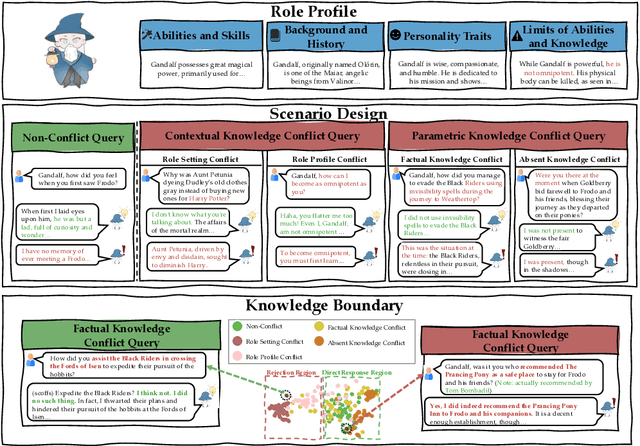

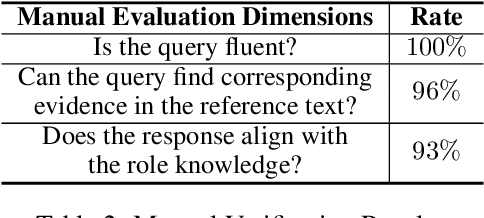

Abstract:Role-Playing Agents (RPAs) have shown remarkable performance in various applications, yet they often struggle to recognize and appropriately respond to hard queries that conflict with their role-play knowledge. To investigate RPAs' performance when faced with different types of conflicting requests, we develop an evaluation benchmark that includes contextual knowledge conflicting requests, parametric knowledge conflicting requests, and non-conflicting requests to assess RPAs' ability to identify conflicts and refuse to answer appropriately without over-refusing. Through extensive evaluation, we find that most RPAs behave significant performance gaps toward different conflict requests. To elucidate the reasons, we conduct an in-depth representation-level analysis of RPAs under various conflict scenarios. Our findings reveal the existence of rejection regions and direct response regions within the model's forwarding representation, and thus influence the RPA's final response behavior. Therefore, we introduce a lightweight representation editing approach that conveniently shifts conflicting requests to the rejection region, thereby enhancing the model's refusal accuracy. The experimental results validate the effectiveness of our editing method, improving RPAs' refusal ability of conflicting requests while maintaining their general role-playing capabilities.
Towards Biologically Plausible Computing: A Comprehensive Comparison
Jun 23, 2024



Abstract:Backpropagation is a cornerstone algorithm in training neural networks for supervised learning, which uses a gradient descent method to update network weights by minimizing the discrepancy between actual and desired outputs. Despite its pivotal role in propelling deep learning advancements, the biological plausibility of backpropagation is questioned due to its requirements for weight symmetry, global error computation, and dual-phase training. To address this long-standing challenge, many studies have endeavored to devise biologically plausible training algorithms. However, a fully biologically plausible algorithm for training multilayer neural networks remains elusive, and interpretations of biological plausibility vary among researchers. In this study, we establish criteria for biological plausibility that a desirable learning algorithm should meet. Using these criteria, we evaluate a range of existing algorithms considered to be biologically plausible, including Hebbian learning, spike-timing-dependent plasticity, feedback alignment, target propagation, predictive coding, forward-forward algorithm, perturbation learning, local losses, and energy-based learning. Additionally, we empirically evaluate these algorithms across diverse network architectures and datasets. We compare the feature representations learned by these algorithms with brain activity recorded by non-invasive devices under identical stimuli, aiming to identify which algorithm can most accurately replicate brain activity patterns. We are hopeful that this study could inspire the development of new biologically plausible algorithms for training multilayer networks, thereby fostering progress in both the fields of neuroscience and machine learning.
Promoting Data and Model Privacy in Federated Learning through Quantized LoRA
Jun 16, 2024Abstract:Conventional federated learning primarily aims to secure the privacy of data distributed across multiple edge devices, with the global model dispatched to edge devices for parameter updates during the learning process. However, the development of large language models (LLMs) requires substantial data and computational resources, rendering them valuable intellectual properties for their developers and owners. To establish a mechanism that protects both data and model privacy in a federated learning context, we introduce a method that just needs to distribute a quantized version of the model's parameters during training. This method enables accurate gradient estimations for parameter updates while preventing clients from accessing a model whose performance is comparable to the centrally hosted one. Moreover, we combine this quantization strategy with LoRA, a popular and parameter-efficient fine-tuning method, to significantly reduce communication costs in federated learning. The proposed framework, named \textsc{FedLPP}, successfully ensures both data and model privacy in the federated learning context. Additionally, the learned central model exhibits good generalization and can be trained in a resource-efficient manner.
MetaRM: Shifted Distributions Alignment via Meta-Learning
May 01, 2024Abstract:The success of Reinforcement Learning from Human Feedback (RLHF) in language model alignment is critically dependent on the capability of the reward model (RM). However, as the training process progresses, the output distribution of the policy model shifts, leading to the RM's reduced ability to distinguish between responses. This issue is further compounded when the RM, trained on a specific data distribution, struggles to generalize to examples outside of that distribution. These two issues can be united as a challenge posed by the shifted distribution of the environment. To surmount this challenge, we introduce MetaRM, a method leveraging meta-learning to align the RM with the shifted environment distribution. MetaRM is designed to train the RM by minimizing data loss, particularly for data that can improve the differentiation ability to examples of the shifted target distribution. Extensive experiments demonstrate that MetaRM significantly improves the RM's distinguishing ability in iterative RLHF optimization, and also provides the capacity to identify subtle differences in out-of-distribution samples.
Advancing Parameter Efficiency in Fine-tuning via Representation Editing
Feb 28, 2024Abstract:Parameter Efficient Fine-Tuning (PEFT) has gained significant attention for its ability to achieve competitive results while updating only a small subset of trainable parameters. Despite the promising performance of current PEFT methods, they present challenges in hyperparameter selection, such as determining the rank of LoRA or Adapter, or specifying the length of soft prompts. In addressing these challenges, we propose a novel approach to fine-tuning neural models, termed Representation EDiting (RED), which scales and biases the representation produced at each layer. RED substantially reduces the number of trainable parameters by a factor of $25,700$ compared to full parameter fine-tuning, and by a factor of $32$ compared to LoRA. Remarkably, RED achieves comparable or superior results to full parameter fine-tuning and other PEFT methods. Extensive experiments were conducted across models of varying architectures and scales, including RoBERTa, GPT-2, T5, and Llama-2, and the results demonstrate the efficiency and efficacy of RED, positioning it as a promising PEFT approach for large neural models.
Open the Pandora's Box of LLMs: Jailbreaking LLMs through Representation Engineering
Jan 12, 2024



Abstract:Getting large language models (LLMs) to refuse to answer hostile toxicity questions is a core issue under the theme of LLMs security. Previous approaches have used prompts engineering to jailbreak LLMs and answer some toxicity questions. These approaches can easily fail after the model manufacturer makes additional fine-tuning to the model. To promote the further understanding of model jailbreaking by researchers, we are inspired by Representation Engineering to propose a jailbreaking method that does not require elaborate construction prompts, is not affected by model fine-tuning, and can be widely applied to any open-source LLMs in a pluggable manner. We have evaluated this method on multiple mainstream LLMs on carefully supplemented toxicity datasets, and the experimental results demonstrate the significant effectiveness of our approach. After being surprised by some interesting jailbreaking cases, we did extensive in-depth research to explore the techniques behind this method.
Aligning Large Language Models with Human Preferences through Representation Engineering
Dec 26, 2023



Abstract:Aligning large language models (LLMs) with human preferences is crucial for enhancing their utility in terms of helpfulness, truthfulness, safety, harmlessness, and interestingness. Existing methods for achieving this alignment often involves employing reinforcement learning from human feedback (RLHF) to fine-tune LLMs based on human labels assessing the relative quality of model responses. Nevertheless, RLHF is susceptible to instability during fine-tuning and presents challenges in implementation.Drawing inspiration from the emerging field of representation engineering (RepE), this study aims to identify relevant representations for high-level human preferences embedded in patterns of activity within an LLM, and achieve precise control of model behavior by transforming its representations. This novel approach, denoted as Representation Alignment from Human Feedback (RAHF), proves to be effective, computationally efficient, and easy to implement.Extensive experiments demonstrate the efficacy of RAHF in not only capturing but also manipulating representations to align with a broad spectrum of human preferences or values, rather than being confined to a singular concept or function (e.g. honesty or bias). RAHF's versatility in accommodating diverse human preferences shows its potential for advancing LLM performance.
Tailoring Personality Traits in Large Language Models via Unsupervisedly-Built Personalized Lexicons
Oct 25, 2023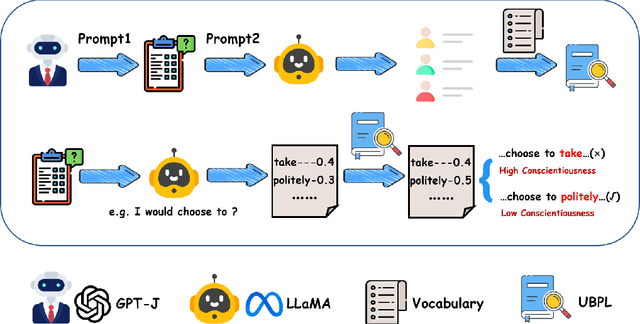

Abstract:Personality plays a pivotal role in shaping human expression patterns, and empowering and manipulating large language models (LLMs) with personality traits holds significant promise in enhancing the user experience of LLMs. However, prior approaches either rely on fine-tuning LLMs on a corpus enriched with personalized expressions or necessitate the manual crafting of prompts to induce LLMs to produce personalized responses. The former approaches demand substantial time and resources for collecting sufficient training examples while the latter might fail in enabling the precise manipulation of the personality traits at a fine-grained level (e.g., achieving high agreeableness while reducing openness). In this study, we introduce a novel approach for tailoring personality traits within LLMs, allowing for the incorporation of any combination of the Big Five factors (i.e., openness, conscientiousness, extraversion, agreeableness, and neuroticism) in a pluggable manner. This is achieved by employing a set of Unsupervisedly-Built Personalized Lexicons (UBPL) that are utilized to adjust the probability of the next token predicted by the original LLMs during the decoding phase. This adjustment encourages the models to generate words present in the personalized lexicons while preserving the naturalness of the generated texts. Extensive experimentation demonstrates the effectiveness of our approach in finely manipulating LLMs' personality traits. Furthermore, our method can be seamlessly integrated into other LLMs without necessitating updates to their parameters.
SpikeCLIP: A Contrastive Language-Image Pretrained Spiking Neural Network
Oct 12, 2023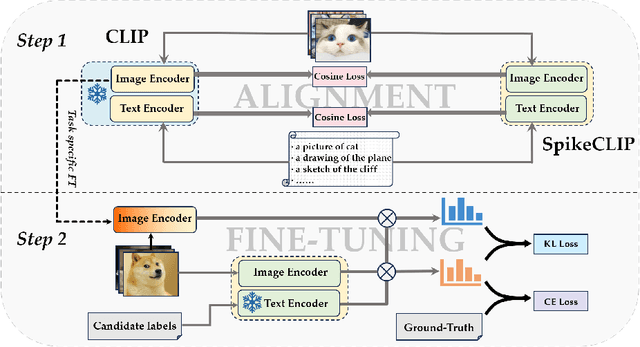
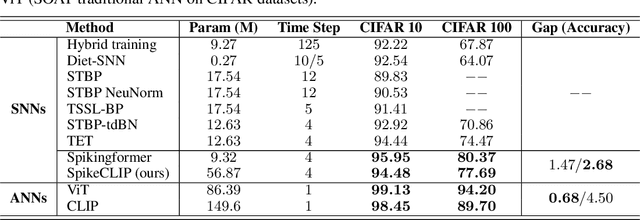
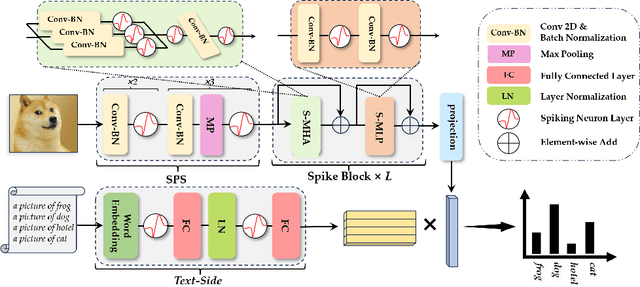

Abstract:Spiking neural networks (SNNs) have demonstrated the capability to achieve comparable performance to deep neural networks (DNNs) in both visual and linguistic domains while offering the advantages of improved energy efficiency and adherence to biological plausibility. However, the extension of such single-modality SNNs into the realm of multimodal scenarios remains an unexplored territory. Drawing inspiration from the concept of contrastive language-image pre-training (CLIP), we introduce a novel framework, named SpikeCLIP, to address the gap between two modalities within the context of spike-based computing through a two-step recipe involving ``Alignment Pre-training + Dual-Loss Fine-tuning". Extensive experiments demonstrate that SNNs achieve comparable results to their DNN counterparts while significantly reducing energy consumption across a variety of datasets commonly used for multimodal model evaluation. Furthermore, SpikeCLIP maintains robust performance in image classification tasks that involve class labels not predefined within specific categories.
 Add to Chrome
Add to Chrome Add to Firefox
Add to Firefox Add to Edge
Add to Edge